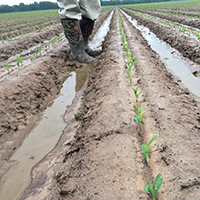
To assess the likely impact of climate change on U.S. agriculture, researchers typically run a combination of climate and crop models that project how yields of maize, wheat and other key crops will change over time. But the suite of models commonly used in these simulations, which account for a wide range of uncertainty, produces outcomes that can range from substantial crop losses to bountiful harvests. These mixed results often leave farmers and other agricultural stakeholders perplexed as to how best to adapt to climate change.
Now, in a study published in Environmental Research Letters and highlighted as the lead story on environmentalresearchweb.org’s Environmental Research Roundup on July 27, 2016, a research team at MIT and the University of California, Davis, has devised a way to provide these stakeholders with the additional information they need to make more informed decisions. In a nutshell, the researchers complement the results of climate/crop model runs with projections of five useful indices of agriculture/climate interaction—dry days, plant heat stress, frost days, growing season length and start of field operations—that clarify what’s driving projected yields up or down.
“It’s very difficult to investigate the impact of the climate on agriculture because models don’t agree even on the sign of projected yield, or indicate the mechanism behind it,” says the study’s lead author Erwan Monier, a principal research scientist with the MIT Joint Program on the Science and Policy of Global Change. “Our work provides an alternative way to look at the fate of agriculture under climate change that provides information that’s more relevant to farmers than existing climate/crop models.”
Using the MIT Integrated Global System Modeling (IGSM) framework, which accounts for key sources of uncertainty and incorporates all five agro-climate indices, Monier and his collaborators ran simulations to estimate the potential effects of climate change on agriculture in the U.S. by 2100.
Under a scenario in which greenhouse gas emissions are unconstrained, the model projected that the U.S. will experience fewer frosts, a longer growing season, more heat stress and an earlier start of ï¬eld operations by the end of the century. When greenhouse gas emissions reduction policies—one aimed at capping the rise in global mean surface temperature between pre-industrial times and 2100 at 2 degrees Celsius, the other targeting a 2.5°C cap—were applied, projected changes in four out of the five indices were cut in half.
This suggests that aggressive greenhouse gas mitigation could sharply reduce the effects of climate change—both adverse ones, such as increased heat stress, and beneficial ones, such as a longer growing season.
The research team also determined that these climate mitigation policies would prevent changes in any of the five indices from exceeding those that arise from natural year-to-year variations in the climate that we already experience, thus limiting the severity of climate-related impacts on agriculture for the rest of the century.
Enabling these results is a new, more efficient, integrated approach to modeling the impact of climate on agriculture and estimating the benefits of climate mitigation efforts.
Rather than relying on the traditional approach of using a multi-model ensemble (the standard one, the CMIP5, comprises more than 30 different climate models) to estimate the uncertainty in the impact of climate change on agriculture, the researchers used multiple simulations of a single model where key sources of uncertainty are explored by varying several model assumptions. These include the response of the global climate system to changes in atmospheric greenhouse gas levels, the natural variability in the climate system, and the emissions scenario selected.
Bypassing the need to run multiple climate models through international coordinated efforts among multiple climate research institutes, the MIT model delivers a similar range of results with far greater efficiency. And because it integrates both climate and economic projections, it provides a more direct estimate of the economic benefit of climate mitigation.
The study was funded by the U.S. Environmental Protection Agency, Department of Energy and National Science Foundation.
Photo: Water stands between the raised beds of corn verification plot on April 15, 2015. (U of Arkansas System Division of Agriculture photo by Kevin Lawson)

